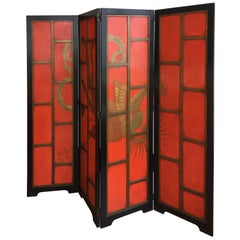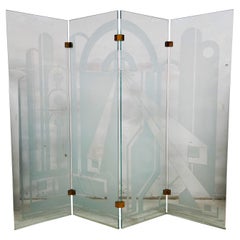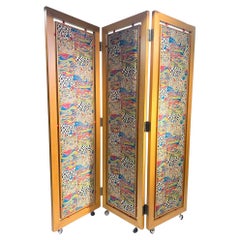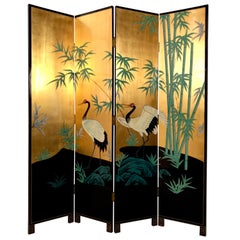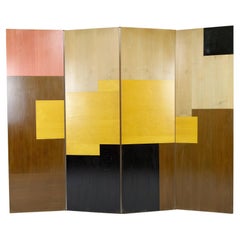Paravent Art Deco
Vintage 1920s Chinese Art Deco Lacquer
Wood
Vintage 1970s Art Deco Screens and Room Dividers
Brass
Late 20th Century French Art Deco Screens and Room Dividers
Fabric, Wood
Recent Sales
Early 20th Century French Art Deco Screens and Room Dividers
Wood
Vintage 1970s French Art Deco Screens and Room Dividers
Wood, Paint
20th Century French Art Deco Screens and Room Dividers
Wood
Vintage 1940s French Mid-Century Modern Screens and Room Dividers
Metal
Mid-20th Century European Art Deco Screens and Room Dividers
Stucco, Wood
People Also Browsed
21st Century and Contemporary Swedish Mid-Century Modern Table Lamps
Textile
Late 20th Century American Modern Sofas
Chrome
Mid-20th Century Swiss Mid-Century Modern Club Chairs
Leather
21st Century and Contemporary American Sofas
Linen, Velvet
Vintage 1960s Italian Mid-Century Modern Dining Room Chairs
Brass, Iron
2010s Austrian Jugendstil Chandeliers and Pendants
Brass
Early 20th Century English Victorian Daybeds
Walnut
20th Century French Mid-Century Modern Screens and Room Dividers
Pine
Vintage 1970s American Futurist Commodes and Chests of Drawers
Plastic, Hardwood
2010s American Modern Wall Lights and Sconces
Brass, Bronze, Enamel, Nickel
Vintage 1960s American Mid-Century Modern Sofas
Fabric, Walnut
Early 20th Century French Art Deco Daybeds
Leather, Wood
Vintage 1970s Italian Mid-Century Modern Vanities
Fabric, Plastic
Antique Early 1900s Italian Art Nouveau Table Lamps
Bronze
Vintage 1960s American Mid-Century Modern Swivel Chairs
Steel, Chrome
Vintage 1980s Swedish Mid-Century Modern Sofas
Chrome
Finding the Right Screens-room-dividers for You
Whether they are implemented as decorative accents or makeshift partitions to ensure privacy, antique and vintage folding screens and room dividers easily introduce sophistication and depth to any space in your home.
The earliest examples of folding screens are said to have originated in China and go back at least as far as the Han dynasty. Screens of the era were heavy structures made of wood and had hinges of cloth or leather. They were adorned with elaborate landscape paintings that were typically created on silk or paper canvases and applied directly to the screen’s panels afterward. Just as they had been in the 20th century and today, the folding screens then were recognized for both their practical and purely decorative properties.
Japanese room-divider screens were also decorated with paintings but constructed to be lightweight and mobile. They took on considerable event-based importance when the structures gained popularity in the East Asian country, as the folding screens were used in performing arts such as concerts, tea ceremonies and more. Later, artists elsewhere warmed to folding screens and sought to create their own.
In European countries such as France, where they were known as paravent, folding screens began to materialize in apartments in Paris, gaining favor with the likes of pioneering couturier Gabrielle “Coco” Chanel, who is said to have accrued more than 30 and used them as a precursor to what we now know as wallpaper.
On 1stDibs, find a wide range of antique and vintage folding screens and room dividers, which, given their history, may do a better job of bringing people and cultures together in your home than sectioning off a space. Search by material to find options in metal, fabric or wood, or browse by style for mid-century modern designs and examples from the Art Deco era.
- What is the history of Art Deco?1 Answer1stDibs ExpertMarch 25, 2024The history of Art Deco begins in the early 20th century.
Art Deco emerged as a global design style around the start of World War I, during the last years of Art Nouveau's popularity. The style conjures visions of the Roaring Twenties, Machine Age metropolises, vast ocean liners, sleek typography and Prohibition-era hedonism. Its hallmarks include the use of geometric designs influenced by Cubism. Major discoveries of Egyptian tombs during the era also influenced the movement.
The term Art Deco derives from the name of a large decorative arts exhibition, the Exposition Internationale des Arts Décoratifs et Industriels Modernes, held in Paris in 1925. After World War II, tastes shifted toward more functional, less ornate modernism, but today, the Art Deco style is still favored for its luxurious sophistication. On 1stDibs, shop a large selection of vintage Art Deco furniture. - How do I identify Art Deco?1 Answer1stDibs ExpertApril 5, 2022To identify Art Deco, look for the characteristics of the period. Furniture produced at the time is generally lacquered metal with a mirror-like glossy finish. Wooden items should be an exotic wood. Most items feature symmetrical designs, and geometric forms were popular motifs during the period. In addition, Art Deco often shows the influence of Hellenistic, Egyptian and Asian designs. Shop a variety of Art Deco furniture and decorative objects on 1stDibs.
- What was Art Deco influenced by?1 Answer1stDibs ExpertMay 3, 2024Art Deco was influenced by a number of things. The discovery of ancient tombs around the turn of the century led to a renewed interest in Egyptian furniture and architecture that inspired Art Deco designers. Art Deco was also informed by Cubism, Futurism, Louis XVI style, De Stijl, modernism and the Vienna Secession. Shop a large collection of Art Deco furniture, decorative objects and jewelry on 1stDibs.
- What is an Art Deco lamp?1 Answer1stDibs ExpertApril 5, 2022An Art Deco lamp is any lamp that’s made in the styles of the Art Deco movement, which was dominant in the 1920s and 1930s. On 1stDibs, you’ll find a collection of Art Deco lamps from some of the world’s top sellers.
- What is art deco ring?1 Answer1stDibs ExpertAugust 17, 2021Art Deco rings were made during the early 20th century. Named for a design movement that originated at a large decorative arts exhibition held in Paris in 1925, Art Deco rings are generally quite geometric, symmetrical and incorporate a variety of gemstones — especially sapphires and emeralds. Find a wide variety of Art Deco rings for sale on 1stDibs.
- When did Art Deco originate?1 Answer1stDibs ExpertFebruary 1, 2024The Art Deco period originated in France. Its name comes from the title of a large decorative arts exhibition held in Paris in 1925, credited with introducing the style to the world. It was informed by ancient Egypt, Cubism, Futurism, Louis XVI, De Stijl, modernism and the Vienna Secession and went on to influence the Streamline Moderne and mid-century modern movements. Shop a wide range of Art Deco furniture, decorative objects and jewelry on 1stDibs.
- What defines Art Deco?1 Answer1stDibs ExpertApril 5, 2024A few things define Art Deco. Date is one factor, as the style emerged in the 1920s and remained popular during the 1930s. Art Deco design usually includes bold geometric lines and forms or intricate repeating floral motifs. Designers working in this style tended to use expensive materials, such as shagreen or marble, as well as exotic woods like mahogany, ebony and zebra wood. Furniture often featured metal accents, mirrored finishes and embellishments made from exotic animal hides and inlays of mother-of-pearl or ivory. Shop a wide range of Art Deco furniture on 1stDibs.
- What was the Art Deco movement?1 Answer1stDibs ExpertMay 30, 2024The Art Deco movement was a decorative style popular during the 1920s and ’30s. Few design styles are as universally recognized and appreciated as Art Deco. The term alone conjures visions of the Roaring Twenties, Machine Age metropolises, vast ocean liners, sleek typography and Prohibition-era hedonism. The iconic movement made an indelible mark on all fields of design, celebrating society's growing industrialization with refined elegance and stunning craftsmanship. Widely known designers associated with the Art Deco style include Émile-Jacques Ruhlmann, Eileen Gray, Maurice Dufrêne, Paul Follot and Jules Leleu. The term Art Deco derives from the name of a large decorative arts exhibition held in Paris in 1925. On 1stDibs, shop a wide range of Art Deco furniture and decorative objects.
- What is an art deco watch?1 Answer1stDibs ExpertApril 5, 2022An art deco watch is defined by its geometric case, which is either circular or rectangular. The watch style was highly popular between 1920 and 1950, and is still sought after today. You’ll find a collection of art deco watches from some of the world’s top sellers on 1stDibs
- What is art deco jewelry?1 Answer1stDibs ExpertFebruary 22, 2021Art Deco jewelry was popular during the design movement of the 1920s and 30s. Art Deco jewelry is typically characterized by geometric patterns and gemstones of contrasting colors.
- 1stDibs ExpertAugust 15, 2019
The main difference between Art Nouveau and Art Deco is that the former is detailed and ornate, and the latter is sharp and geometrical. When the movement started at the end of the 19th century, Art Nouveau was heavily influenced by nature and the curved lines of flowers. Art Deco, which became popular in the beginning of the 20th century, was inspired by the geometric abstraction of cubism.
- 1stDibs ExpertFebruary 13, 2023To know if a ring is Art Deco, examine its style. The Art Deco period, encompassing the 1920s and ’30s, ushered in a very distinct look in the design of jewelry. Makers often incorporated geometric motifs in jewelry designs. Materials may also provide a clue about the era of the piece. Platinum, rubies, sapphires and emeralds were some of the most common precious metals and gemstones used at the time. Keep in mind that there are many convincing reproductions of Art Deco rings and other high-quality pieces inspired by originals. As a result, you may wish to have a certified appraiser or expert within the field of antique jewelry design to evaluate the ring. Shop a selection of Art Deco rings on 1stDibs.
- Is Art Deco jewelry valuable?1 Answer1stDibs ExpertFebruary 1, 2024Yes, some Art Deco jewelry is valuable. Jewelry from the 1920s and ’30s has remained consistently popular. It experienced a major revival in the 1960s, and even today, jewelry makers continue to be inspired by the period. As a result, demand for Art Deco jewelry is typically high, but the actual value of a piece depends on its style, maker, age and condition. A certified appraiser or experienced antiques dealer can help you determine how much your jewelry is worth. Explore a large selection of Art Deco jewelry on 1stDibs.
- How was Art Deco furniture made?1 Answer1stDibs ExpertApril 5, 2022Art Deco furniture was largely made by hand. Crafters often employed exotic hardwood like zebra wood, rosewood and Macassar ebony. Many pieces had a polished Japanese lacquer finish, which gave a high-gloss shine to the wood. On 1stDibs, shop a variety of Art Deco furniture.
- Is Toulouse-Lautrec Art Deco?1 Answer1stDibs ExpertApril 5, 2022The work of French artist Henri de Toulouse-Lautrec falls into the Art Nouveau style, which was prevalent approximately during the period of 1890-1910. Following the Art Nouveau period was the Art Deco era, which is usually defined as the era between 1920 and 1930. Toulouse-Lautrec died in 1901 putting his art in the era of Art Nouveau, but certain aspects of it definitely hint at the coming Art Deco style considering the definite overlap of the two movements. On 1stDibs, find a variety of original artwork from top artists.
- 1stDibs ExpertNovember 8, 2023Art Deco engagement rings are accessories that were produced during the 1920s and '30s and are characterized by details associated with the Art Deco style. They're often very colorful and feature bold geometric lines as well as gemstones cut in nontraditional ways. While the style got its name from an arts exhibition in Paris in 1925, Art Deco was inspired by Cubism and a shift from Art Nouveau's floral aesthetic. The modern look of Art Deco engagement rings reflects an evolution in fashion, visual art and more, as well as the sweeping societal changes taking hold at the time. On 1stDibs, shop a range of vintage Art Deco engagement rings.
- What are art deco lamps made of?1 Answer1stDibs ExpertApril 5, 2022Art deco lamps come in a variety of shapes, sizes and styles. Vintage art deco-style lamps were made of natural materials such as metal, glass and pottery. You’ll find a variety of art deco lamps from some of the world’s top sellers on 1stDibs.
- 1stDibs ExpertFebruary 27, 2024To identify Art Deco furniture, first look for maker's markings in inconspicuous areas. Once you've found them, use trusted online resources to research the manufacturer and determine whether they were active during the Art Deco era, which spanned from the 1920s through the 1930s. You can also look for classic characteristics of Art Deco furniture, such as bold geometric lines and forms, intricate floral motifs, metal accents, mirrored finishes and fine materials such as shagreen, marble, mahogany wood, zebra wood, ebony, exotic animal hides, onyx and mother-of-pearl. A certified appraiser or knowledgeable antiques dealer can also assist you with making identifications. Shop a collection of Art Deco furniture on 1stDibs.
- 1stDibs ExpertAugust 15, 2019
Art Deco style furniture appeared right before the start of World War I and is defined by sharp lines, vibrant colors and bold patterns. Heavily influenced by geometry, Art Deco furniture was born out of the Cubism movement.
- 1stDibs ExpertAugust 26, 2024The difference between Art Deco and mid-century modern (MCM) is that the terms describe two distinct design styles. Art Deco typically refers to pieces produced between the 1920s and 1930s. Furniture produced in this style tends to display bold geometric lines and forms, floral motifs, metal accents, shimmering mirrored finishes and embellishments made from exotic animal hides, inlays of mother-of-pearl or ivory. MCM, or mid-century modern, emerged after World War II. Organically shaped, clean-lined and elegantly simple are three terms that well describe vintage mid-century modern furniture. Designers working in this style frequently used industrial materials, including steel, fiberglass, molded plywood, and alluring woods such as teak, rosewood and oak. Explore a wide variety of Art Deco and mid-century modern furniture on 1stDibs.
